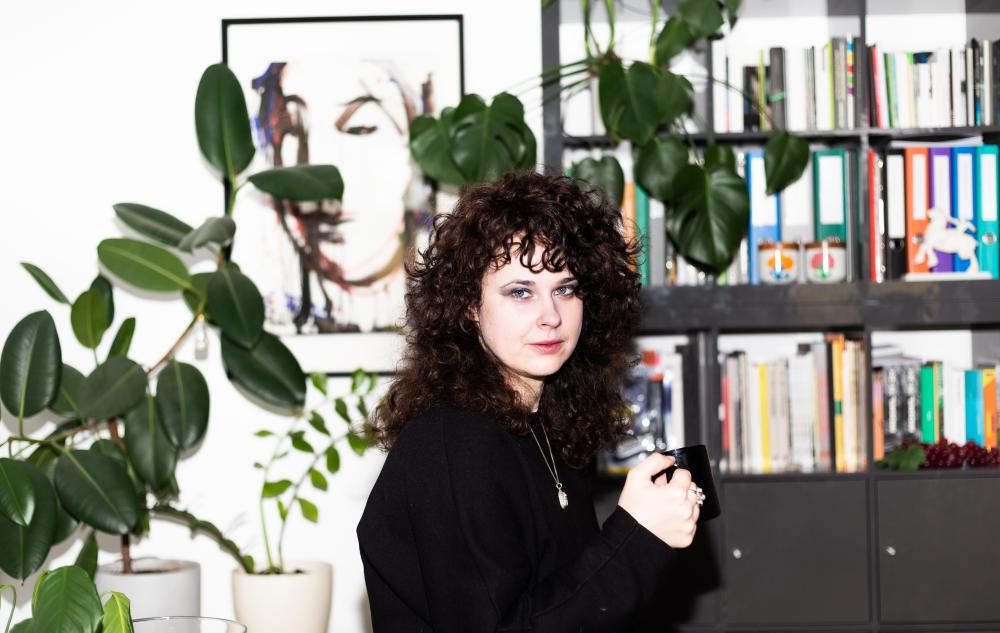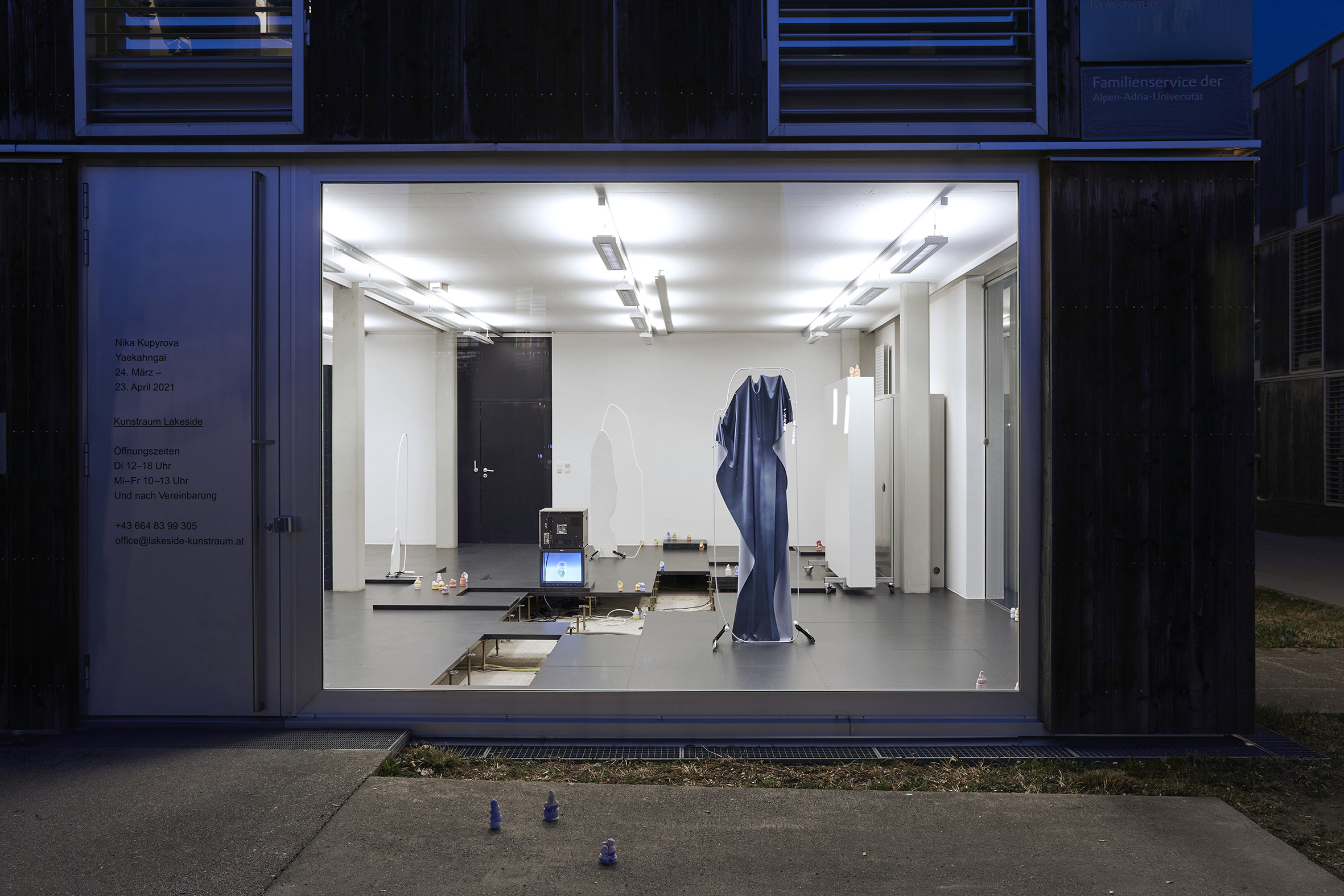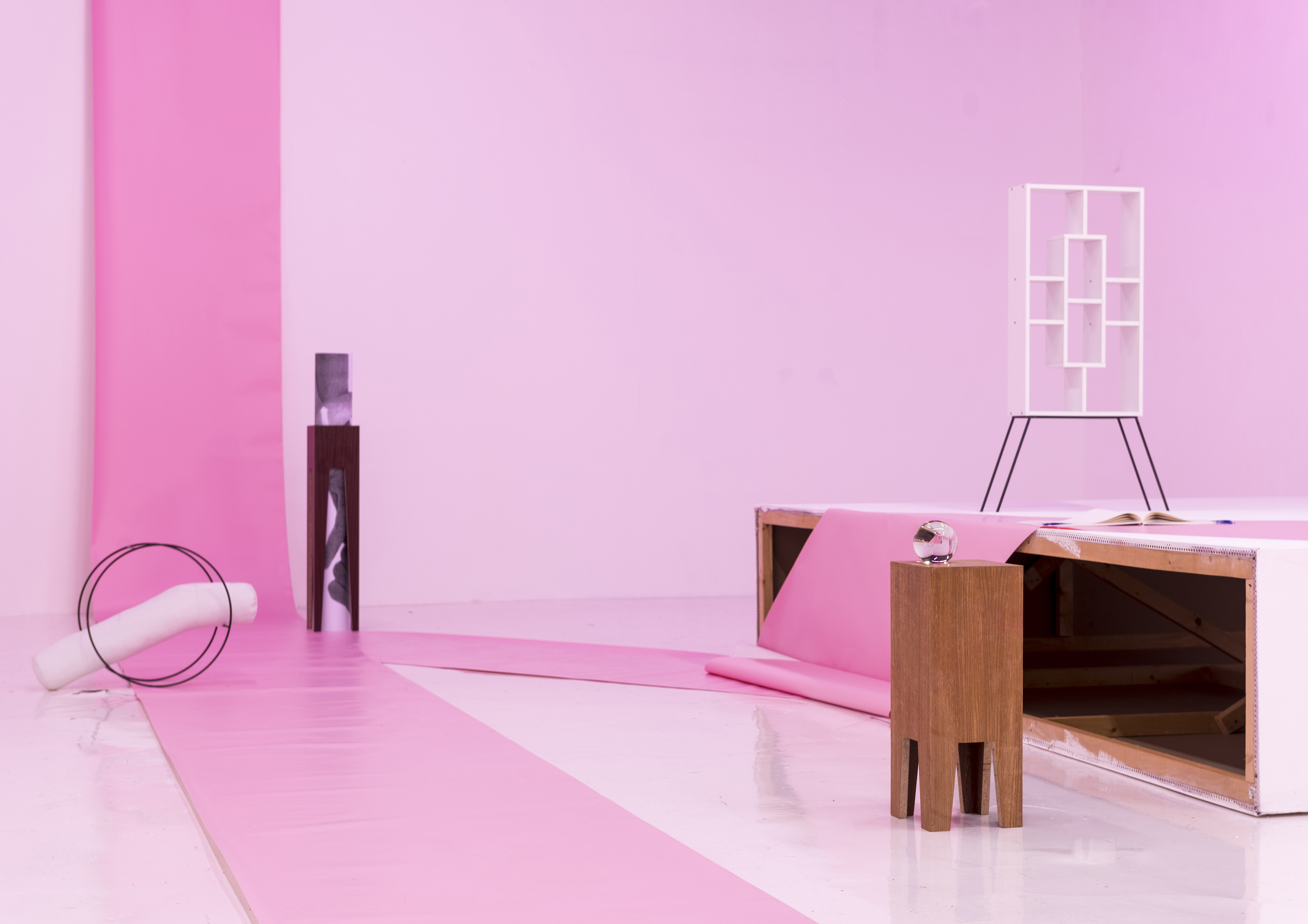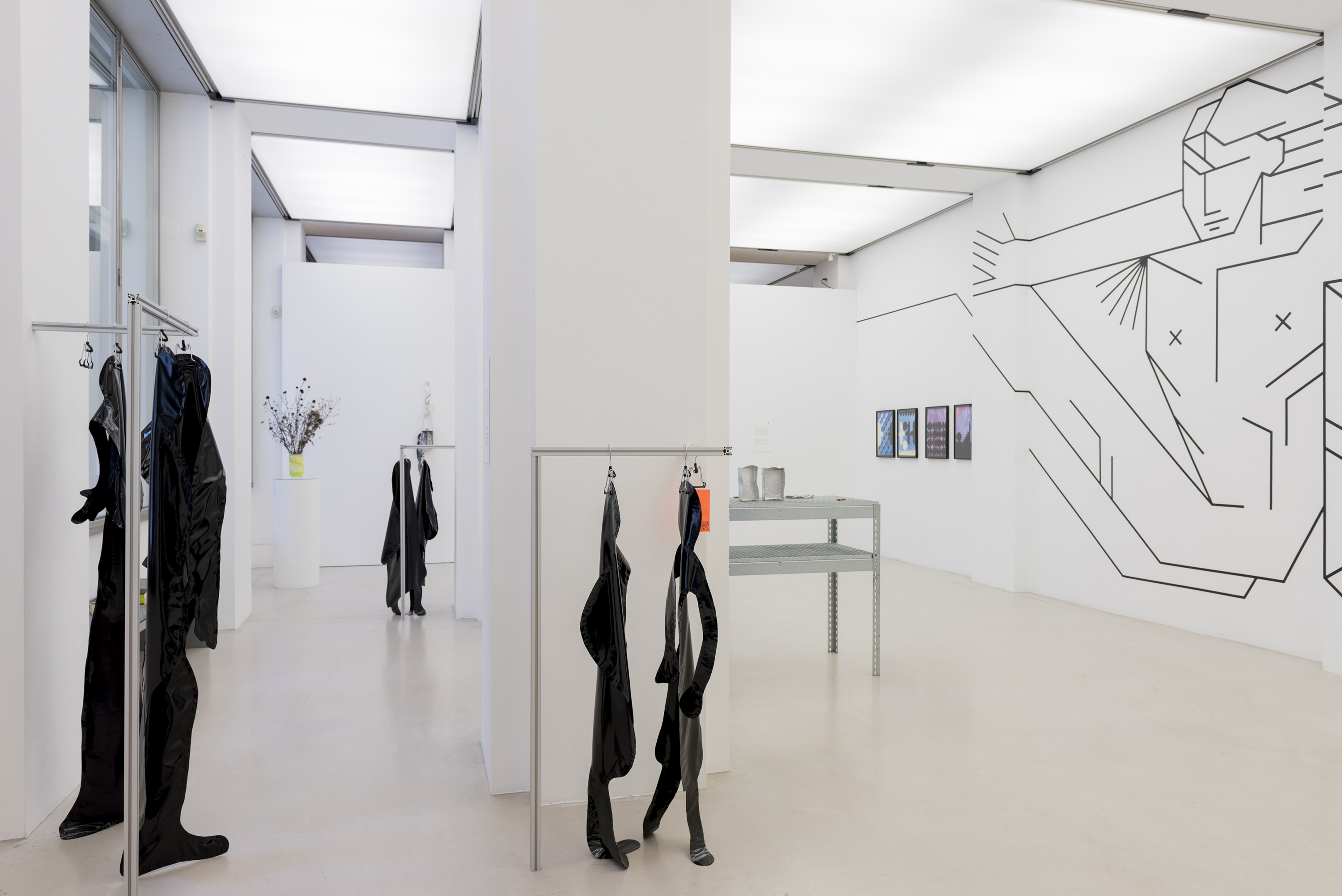
Série rozhovorů Off-Site Conversations otevírá s další výtvarnou osobností témata nového chápání uměleckého ateliéru v městském, regionálním a přeshraničním prostoru. Tentokráte se s umělkyní Nikou Kupyrovou* zaměříme na její interdisciplinární uměleckou praxi v rakousko-českém prostoru, ve kterém se pohybuje a působí, a společně se dotkneme otázek sociopolitického vlivu prostoru a prostředí ve vztahu k její umělecké tvorbě.
For english version scroll down.
„Takový ten pocit, že jsem odevšad a trochu odnikud.“
Překračování hranic, překlápění významů, transgrese – stručný výčet klíčových slov, která popisují kompaktní a vizuálně působivé instalace umělkyně Niky Kupyrové. V její umělecké praxi se střídá komplexnost a ironie, přičemž si je zcela vědomá historických referencí, společenských hierarchií a klišé. Její prostorové instalace jsou velmi precizní a do detailu promyšlené. Nika Kupyrová tak vytváří vlastní mytologii, která v jejích instalacích navozuje specifickou atmosféru bezčasí a nemísta.
Narodila ses v Kyjevě, studovala v Česku, Skotsku a Rakousku. Jak se tato specifická zkušenost promítá do tvé umělecké praxe?
Má rodina se přestěhovala z Ukrajiny do Prahy v roce 1993, když mi bylo 8 let, a od té doby jsem pak vyrůstala v Praze. Byla jsem zvyklá, že nejsem nikde úplně doma. Takový ten pocit, že jsem odevšad a trochu odnikud, jsem měla vlastně odjakživa. Možná proto pro mě nebyl žádný velký krok pohybovat se mimo Česko v dalších zemích a já si později vybrala Skotsko, kde jsem studovala umění na Edinburgh College of Art. Platí tam trochu jiná pravidla a stát podporuje studium studentů z Evropské unie. Rodiče jsou oba umělci, malíři. Já jsem naopak dělala prostorové věci. Ze začátku hodně site-specific rázu, mám z té doby většinou jen fotodokumentaci těch instalací, neboť byly myšleny spíše jako efemerní intervence. Ještě ve Skotsku se mé věci silně zabývaly tématy určitého off-site pocitu. Nyní už tvořím abstraktněji, nekonkrétně a organičtěji, ale těžištěm zůstává prostor. Jde až o určitý scénografický přístup. Vyzkoušela jsem samozřejmě i jiná média a přístupy, ale nic mi nesedělo tak jako instalační a prostorové umění.

Nika Kupyrova “Yaekahngai”, instalace v Kunstraum Lakeside (2021), foto Johannes Puch
Nakonec ses ze Skotska přesunula do Vídně, kde jsi absolvovala na die Angewandte ve Vídni v ateliéru TransArts. Co konkrétně tě do Vídně přivedlo?
Paradoxně jsem do Vídně nikdy předtím nejela, když jsem žila v Praze. Přijela jsem do Vídně až ze Skotska díky pozvání na výstavu a krátkou uměleckou rezidenci. V té době jsem už aktivně vystavovala a měla mezi bakalářským a magisterským studiem pětiletou přestávku. Na TransArts jsem tedy přišla už zkušenější. Německy jsem ze začátku moc neuměla, ale velkou překážkou to nebylo. Vždycky se šlo nějak domluvit. Ve Vídni se mi líbilo a za tu dobu co tu bydlím, jsem si vytvořila zázemí, které ke své tvorbě potřebuji. Občas přemýšlím, jaké by to bylo bydlet někdy ještě v nějaké jiné zemi, ale představa, že žiji někde ve vzduchoprázdnu, je pro mě absolutně nemožná.
Pohybuješ se mezi různými místy, městy a institucemi. Myslíš si, že umělkyně*lec má cestovat, stát se jakýmsi nomádem?
Nomádství mi není vůbec vlastní, přestože jsem žila na různých místech. Vážím si zázemí a potřebuji ho k životu i k práci. Samozřejmě jsou umělci, kteří jsou přesně takovými nomády, ale pravda je taková, že jich není hodně. Je to spíše takový mýtus, který je problematický v tom, že jsou na něj nastaveny různé programy, ale málokdo si to může reálně dovolit. Ano, můžeš několik let za sebou cestovat napříč rezidencemi, ale to vyžaduje uměleckou praxi, která je k tomu vhodná, například práce, při které si vystačíš s laptopem. Také nemůžeš mít závazky typu byt, práce, rodina. Takže ano, na jedné straně tu je ten lákavý životní styl nomáda, ale na straně druhé se vzdáváš zázemí a nějaké jistoty a ukotvenosti v životě.
Zároveň je pro umělce důležité mít přístup k zahraničním možnostem umělecké práce a spolupráce. Já se snažím cestovat často ze své vlastní iniciativy, ovšem i podle toho, co si můžu momentálně dovolit, ať už z časových nebo finančních důvodů.

Nika Kupyrova “Otis Rem”, instalace v Tomas Umrian Contemporary (2018), foto Adam Šakový
Jak bys popsala své zkušenosti se spoluprací s rakousko-českou uměleckou scénou? Myslíš si, že je taková přeshraniční spolupráce přínosná, a dochází k ní vůbec, existují nějaké formy podpory?
Jak jsem se zmínila předtím, tak jsem vlastně ve Vídni předtím nebyla, když jsem vyrůstala v Praze. Já se nějak organicky snažím propojovat a komunikovat s českou scénou, ale pořád se například z Prahy víc jezdí do Berlína. Když ale porovnám obě ty umělecké scény, rakouskou a tu českou, tak si jsou, co se nějaké struktury týče, hodně podobné. Ve Vídní jsou například také dvě umělecké školy, ekvivalenty pražské Umprum a Akademie.
Je to takový až paralelní svět. Vidím, že se to teď už hodně proměňuje a že je i víc českých studentů v Rakousku než předtím.
Jsi vizuální umělkyně, zároveň kurátorka a architekta výstav. Jak se tyto role vzájemně ovlivňují, prolínají nebo naopak vymezují?
Tím, že jsem studovala umění, tak mi nechybí akademicky kontext. Ke kurátorství jsem se pak dostala vlastím zájmem. Poprvé jsem si to vyzkoušela s kolegy z TransArts ještě během studií. Navedl mě k tomu taky vlastní specifický přístup v mé umělecké praxi, který je hodně narativní a odehrává se v prostoru, kde mezi sebou objekty komunikují. Ten samý přístup aplikuji i na práce jiných umělců. Zajímá mě, co vznikne, když jsou díla spolu v dialogu, jaké nové významy a interpretace se tím vytvoří. Navíc mám díky tomu možnost psát kurátorské texty, ke kterým vždy přistupuji velmi kreativně. Psaní mě baví a jinak se k němu z časových důvodů zřídka dostanu.
Pracuješ hodně s příběhy z knih různých žánrů, v případě výstavy v MUSA Startgalerie DISPATCHES FROM A TROUBLED CITY ses nechala inspirovat knihou Perdido Street Station autora fikčního žánru Chiny Miévilleho. Tvé práce však příběhy neilustrují, naopak je přepisují, posouvají do další imaginativní úrovně. Popsala bys blíže tento postup?
Pro DISPATCHES FROM A TROUBLED CITY vystupuji v roli kurátorky, tentokrát v rámci programu Wien Museum MUSA, kde prezentují mladé kurátorské pozice. Skupinovou výstavu jsem sestavila z osobností z umění i designu působících ve Vídni a rozhodla se pro experimentální pojetí kurátorského textu. Z pozice kurátorky, která je také umělkyní, mám možnost pracovat transgresivně, dělat věci, co se nesmí, tím je přepisuji a posouvám jinam. V tomhle případě jsem pracovala s apropriací textu přímo z románu, který na výstavě přejímá funkci kurátorského komentáře k vystaveným dílům.
V sci-fi a dystopickém univerzu Perdido Street Station se potkávají velmi relevantní a aktuální témata k současné výtvarné scéně a stavu světa všeobecně. Je to kniha v žánru spekulativní fikce, kde se fiktivní velkoměsto New Crobuzon stává jakýmsi hlavním protagonistou. Nepracuji tady s knihou jako s referencí, ale spíš jako s mapou nebo metodou. Kombinuji přitom pasáže z knihy s uměleckými díly a nechávám diváky rozluštit, co jsou ona pojítka mezi nimi. V názvu výstavy se pak ukrývá hádanka, takzvaný „easter egg“, kterou může rozluštit jen divák, který knihu přečetl – pro ostatní zůstává název v interpretativní rovině.

Dispatches from a Troubled City, foto Lea Sonderegger
Tvoříš instalace pro specifická místa? Mohou být chápána v jiných kontextech a souvislostech? Ovlivňuje tvou tvorbu to, kde tvoříš?
Své práce sice tvořím v ateliéru, ale většinou na nich začínám pracovat už v rámci připravované samostatné výstavy. Nejsou tedy site-specific ve smyslu, že jsou určené pro specifický prostor, ale jednotlivé objekty jsou už dopředu součástí výstavních celků a instalací. To znamená, že si nemohu v ateliéru vyzkoušet výslednou podobu – ta se ukáže až na výstavě v dialogu s konkrétním prostorem. Samozřejmě objekty mohou být prezentovány i samostatně a na skupinových výstavách, ale ráda je vždy alespoň jednou vystavím takto v jejich vlastním univerzu. Myslím, že je to trochu ironie dělat fyzické věci v post-digitálním kontextu, ale práci u laptopu nadále ve stejné míře střídám s vytvářením soch. Času stráveného v ateliéru si vážím. Je to moje pracovní místo, a když ke mně přijdou hosté, dodá jim návštěva také kontext k mé tvorbě.
---
* Nika Kupyrova se narodila v Kyjevě. Bakalářské studium umění absolvovala na Edinburgh College of Art ve Skotsku a magisterské studium na die Angewandte ve Vídni v ateliéru TransArts. Je interdisciplinární umělkyní a žije a pracuje ve Vídni a v Praze, kde aktivně vystavuje. V blízké době vyjde samostatná publikace shrnující její dosavadní uměleckou tvorbu.
Text vychází s podporou AKTION Rakousko – Česká republika.
Úvodní foto: Kristýna Černá
---
ENG:
“I work transgressively, do things in a wrong way in order to rewrite them and push them forward."
The series of "Off-site conversations" continues to investigate a new understanding of the artist's studio in urban, regional and cross-border contexts. This time we will focus on visual artist Nika Kupyrova and her interdisciplinary artistic practice in the Austrian-Czech space in which she is currently living and working. Together, we will touch upon the socio-political influence of space and environment and their relation to her artistic work.
"That odd feeling of being from everywhere and nowhere at the same time."
Crossing boundaries, playing with meanings, transgressions: this is a short list of keywords that describe the compact and visually alluring installations of the artist Nika Kupyrova. Her artistic practice oscillates between complexity and irony, while being fully aware of historical references, social hierarchies, and clichés. Her spatial installations are precise and assiduously thought out. Nika Kupyrova thus creates her own mythology, which in her installations evokes a specific atmosphere of timelessness and a “no-place” situation.
You were born in Kyiv, studied in the Czech Republic, Scotland and Austria. How do those specific experiences translate into your artistic practice?
My family moved from Ukraine to Prague in ‘93 when I was 8 years old, and I have done the rest of my growing up in Prague. I became used to not being fully at home anywhere. As long as I remember I had this feeling of being from everywhere and a little bit from nowhere as well. Maybe that's why it wasn’t a big step for me to move outside of the Czech Republic to other countries and I later chose Scotland, where I studied at the Edinburgh College of Art. There are slightly different rules in Scotland compared to the rest of the UK and the state encourages applicants from the European Union with affordable tuition and interesting study opportunities. My parents are both artists, painters. I, on the other hand, was always attracted to spatial things. In the beginning, my work was very site-specific; I mostly only have photo documentation of my installations from that time, as they were meant as ephemeral interventions. Back in Scotland, my artistic work often dealt with a certain ‘off-site’ feeling. Now I create in a more abstract, non-specific and organic way, but the focus remains on space. I'd call it a certain scenographic approach. I have experimented with other media and approaches, of course, but nothing suited me as much as installation and spatial art.
Eventually you moved from Scotland to Vienna, where you graduated from die Angewandte in Vienna at the TransArts studio. What specifically brought you to Vienna?
Ironically, I have never been to Vienna while I was still living in Prague. I came to Vienna all the way from Scotland thanks to an invitation for an exhibition and a short artist residency. At the time I was already actively exhibiting and altogether it took me five years after my graduation from Edinburgh College of Art to start studying again at die Angewandte. So, I came to TransArts already fairly experienced. I didn't speak much German at the beginning, but in the art scene it wasn't a big obstacle. There was always a way to communicate. I liked Vienna and through the years I have spent here I managed to create a base I need for my work. Sometimes I wonder what it would be like to live in another country, but the idea of living in a vacuum is unacceptable for me.
You move between different places, cities, and institutions. Do you think an artist should travel, become a kind of nomad?
Nomadism isn’t for me at all, even though I have lived in many different places. I appreciate having a base and a supportive environment for my life and work. Of course, there are artists who are such nomads, but the truth is that there aren’t many of them. It's more of a myth, which is problematic because so many programs are set up according to this understanding of artistic practice, while in reality few people can afford such a lifestyle. Yes, you can travel from one artist’s residency to the next for a few years in a row, but that requires an artistic practice that is suited to it, such as working primarily on your laptop. You also can't have commitments like an apartment, a job, or a family. So yes, on the one hand there's that allure of nomadic lifestyle, but on the other hand you're giving up your base and some security and grounding in life. At the same time, it is important for artists to have access to international opportunities for artistic work and collaboration. I try to travel often on my own initiative, according to what I can afford at the moment, whether it is in terms of time or finances.
How would you describe your experience of working with the Austrian and Czech art scenes? Do you think that such cross-border cooperation is beneficial, and does it happen at all, are there any forms of support?
As I mentioned before, I hadn't actually been to Vienna when I was still living in Prague. In a way I am still exploring both art scenes and their specifics. I'm trying to organically communicate with the Czech scene and establish cooperation, but for example there is still more travel from Prague to Berlin than it is to Vienna. However, when I compare the two art scenes, the Austrian one and the Czech one, they are very similar in terms of structure. In Vienna there are also two art universities, equivalents of Prague's Umprum and Akademie. It's almost like a parallel world. I see that things are changing a lot now and that there are more Czech students in Austria than before.
You are a visual artist, curator, and exhibition architect. How do these roles interact, intersect, or limit each other?
Having studied art, a certain academic context isn't foreign to me. I gravitated towards curating mainly through my own interest, with my first attempt at curating involving the works of my colleagues at the TransArts during my studies. My curatorial approach is influenced by my own artistic practice, which is very narrative-based and geared towards communication between the objects within the space. I am interested in what arises when the works are in dialogue with each other, what new meanings and interpretations are generated. In addition, it gives me the opportunity to write curatorial texts, which I always approach very creatively. I enjoy writing, and rarely get to dedicate my time to it otherwise.
You work a lot with narratives from literary works of different genres, in the case of the exhibition at MUSA Startgalerie "DISPATCHES FROM A TROUBLED CITY" it was inspired by the book "Perdido Street Station" by speculative fiction author China Miéville. But your works don't illustrate stories, on the contrary, they rewrite them and take them to another imaginative level. Could you describe this process in more detail?
For "Dispatches from a Troubled City" I act as a curator, this time as a part of the program of Wien Museum MUSA, dedicated to presenting young curatorial positions. I have composed a group exhibition of artists as well as designers working in Vienna and decided to take an experimental approach to a curatorial text. From my position of a curator, who is also an artist, I have the opportunity to work transgressively, do things in a wrong way in order to rewrite them and push them forward. In this case, I worked with text appropriated directly from the novel, which takes on the role of a curatorial commentary to the exhibited works. The dystopian universe of Perdido Street Station effortlessly brings together themes that are relevant to my colleagues in the art scene and to the state of the word in general. It's a book in the speculative fiction genre, taking place in a metropolis New Crobuzon that becomes a kind of protagonist in its own right. I'm not working with the book as a reference here, but rather used it as a map or a method, combining passages from the book with exhibited artworks and let the audience unravel the connections between them. The title of the exhibition hides a riddle, the so-called "easter egg", which can only be deciphered by a viewer who has read the book - for others, the title remains on an interpretive level.
Do you create installations for specific locations? Can they be understood in other contexts? Does where you create influence your work?
Although I create my works in the studio, I usually start working on them as a part of a forthcoming solo exhibition. They are therefore not site-specific in the sense that they are designed for a specific space, but the individual objects are always conceived as a part of an installation and an exhibition concept. This also means that I can't try out the final form beforehand in my studio - it will only reveal itself at the exhibition in dialogue with the specific space. Of course, the objects can also be presented individually and in group exhibitions, but I always like to exhibit them at least once within their own ‘universe’. I think it's a bit ironic to do physical things in a post-digital context, but I alternate working at the laptop with creating sculptures. I value the time spent in the studio. It is my place of work, and when guests come to visit me, it also provides them with a bit of context for my artistic practice.
---
*Nika Kupyrova was born in Kiev. She completed her Bachelor of Arts at Edinburgh College of Art in Scotland and later her Master's degree at die Angewandte in Vienna at the TransArts studio. She is an interdisciplinary artist and lives and works in Vienna and Prague, where she also actively exhibits. A solo publication focusing on her artistic work over the last six years is coming out this Autumn at Verlag für moderne Kunst.
The text is published with the support of AKTION Austria - Czech Republic. Translation by Nika Kupyrova.
Photography by Kristýna Černá, location_at Nika Kupyrová's apartment in Vienna.